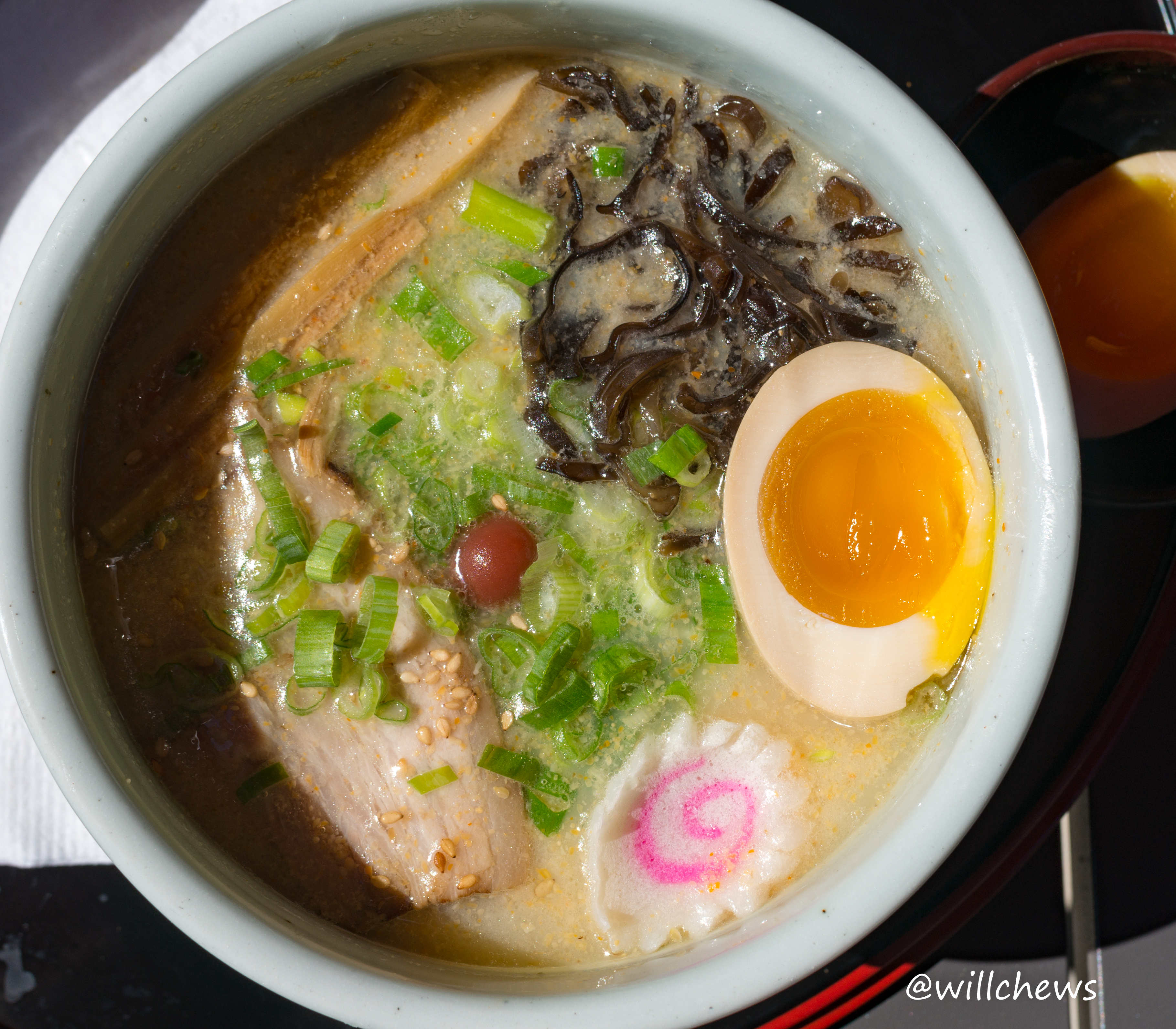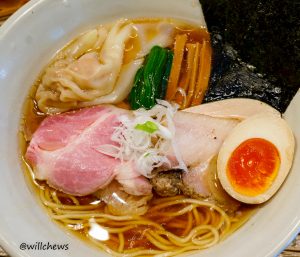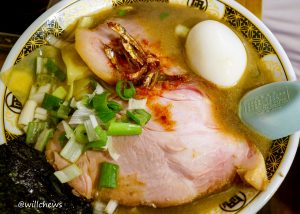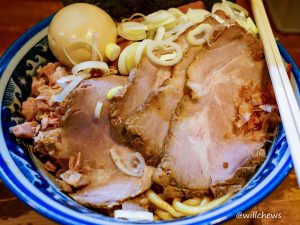Santouka is a Japanese ramen chain created in 1983 in the city of Asahikawa in the northern island of Hokkaido. Asahikawa ramen is distinct: it’s shoyu rather than the corn and butter-laden miso that defines the Sapporo style which usually comes to mind when talking about Hokkaido ramen. However, the signature ramen at Santouka differs from its Asahikawa brethren by using a tonkotsu base and shio tare. The chain has 61 shops around the world and has been pursuing overseas expansion; Food’s Style USA has been the group spearheading this expansion in the US, with its first location opening in Washington in 2014 and spreading to Massachusetts, New Jersey, and now finally Tysons Corner in Virginia. I didn’t eat at Santouka while living in Japan, and the Tabelog ratings of its Japanese shops–like this one in Shinjuku–hover around 3.2/5, which is unimpressive. But my experience with overseas locations of Japanese ramen shops–Tsujita LA (No. 133) and Ippudo, based on my conversation with George Itoh on his experience setting up Ippudo in New York–suggest that they can improve stateside, so I wanted to give Santouka a visit.

The signature tonkotsu-shio is a solid bowl of ramen, served in Santouka’s signature blue bowls that are deeper than standard ramen bowls. What stands out most is the broth, which is porky yet mellow and balanced throughout. It’s different the intensely porky, almost milky tonkotsu broth you get at Ippudo, and it certainly doesn’t have the overly pork-forward flavor that kit broths are guilty of. Eater notes that the broth takes 20 hours to prepare, and a window into the kitchen shows seven or eight large stockpots filled with tonkotsu broth at various stages of preparation. The broth is easily my favorite part of the bowl, but unfortunately the other two primary components–the noodles and the chashu–are less impressive. According to the manger, Kawakami Junichiro, import restrictions on certain types of Japanese flour means that noodles are not made by Santouka but sourced from Kobayashi Seimen, which I presume are based on its North Land line. The noodles are supposed to be springy and pair well with all types of broth, but mine were overcooked and lacked the expected bounce. The two strips of pork belly chashu were not as disappointing but still forgettable: thin and neither deeply roasted (as Santouka’s promotional pictures would suggest) nor finished in any waybefore serving. The other toppings–menma, kikurage, and the ajitama–were all solid. Santouka places umeboshi (Japanese pickled plum) on top of the ramen as a decorative palate cleanser, much like how other shops use beni shoga (red pickled ginger). Neither really appeals to me, but the I like how the umeboshi is less obtrusive than the beni shoga, which has the undesirable tendency to mix into the broth.

Santouka also offers combos whereby you can get a donburi–either chashu or salmon/salmon roe–or gyoza with the ramen. Ramen shop donburis are good idea when you’re hungry and need some extra carbs in your diet, but they work best if a shop has really good chashu like the one I had at Shou. In this case, the chashu in Santouka’s chashu-don are more roasted and have more flavor than its ramen counterpart, but the proportion of chashu to rice is skewed far too much in the weight of the latter, and the diluted chashu juice/gravy not helping matters. It’s still a good deal because the combo comes with a free ajitama that would otherwise be an upcharge, but it could be much better.
Afterwards, I was fortunate to talk to the manager, Kawakami-san, about the preparations Santouka made in setting up shop in Virginia. Kawakami-san himself ran a ramen shop in London, but joined Santouka three years ago to get a understand the ramen business from the perspective of a larger chain. As part of their training, both he and the head chef at the Tysons location were dispatched to the Santouka head office in Japan for six months to learn their methods. When they opened the Virginia shop back in August, the normal procedure would’ve been for Santouka to dispatch people from Japan to observe the opening and ensure flavor quality control; COVID prevented that, but Kawakami-san was able to ask the managers of the New Jersey and one of the Boston shops to come down and get their input. Kawakami-san argues that his aime is to make tonkotsu ramen that appeals a wide cross-section of customers by providing mellow flavors the avoid the worst of the fatty excesses and punchiness of tonkotsu of other tonkotsu ramen shops.
To that extent, I think he’s succeeded. Santouka makes a good broth and is a fine destination if one is in the mood for tonkotsu ramen, thanks to the hard work and time the staff put into making a broth with balanced flavors. There’s still some room for improvement: the overcooked noodles made it hard to judge their quality, the ramen chashu should have more personality, and the balance between chashu and rice in the chashu-don has wrong. But making a good broth is the hardest part, and provided that Santouka is willing to keep tweaking and improving, it’s worth a future re-visit.
COVID Information: Outdoor and socially-distanced indoor seating available. The concrete canyons of the Boro complex means that wind can be an issue for outdoor seating. Street parking is $2.00/30 minutes, yikes. Takeout is available, though I disapprove.
Q(ueue) Factor: None (1100 Sunday)
Sense: While waiting to chat with the manager, I noticed that the speakers were playing a cover of one of the songs from Chrono Trigger, for you JRPG lovers.
Price: $17 (Ramen Combo of any regular-sized ramen, ajitama, donburi/gyoza)
Hokkaido Ramen Santouka (Tysons)
1636 Boro Pl
McLean, VA 22102



